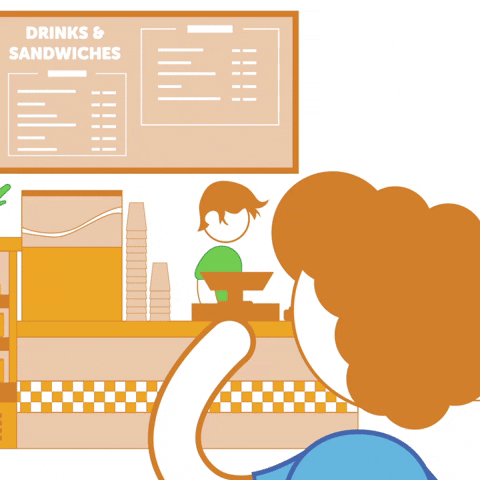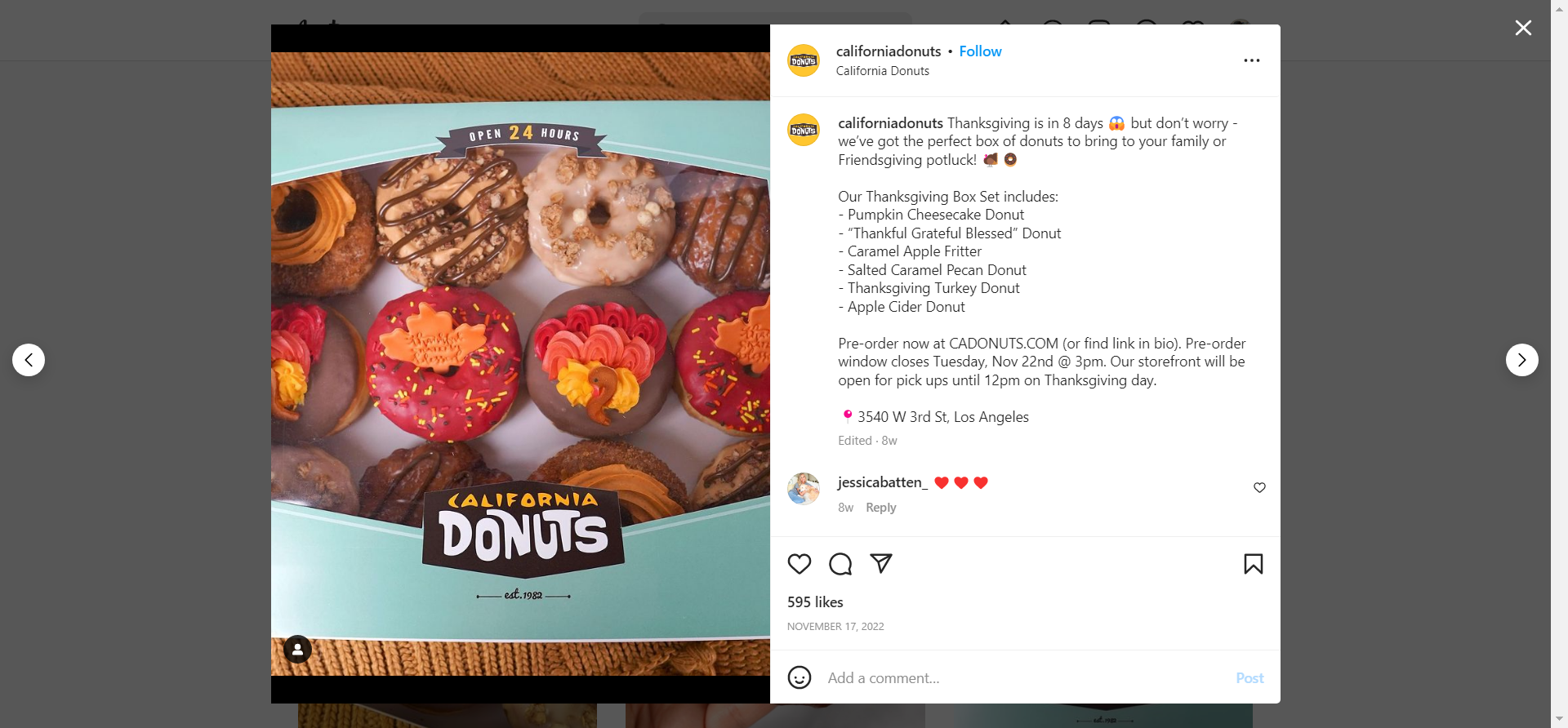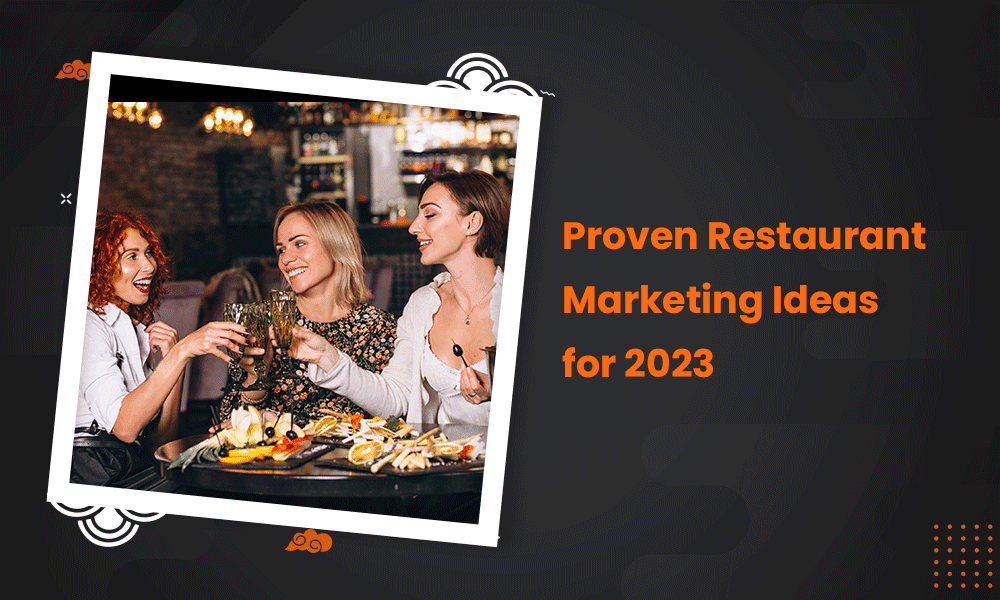Before your restaurant opens for business, you need a full-fledged marketing campaign to engage with potential audiences and hopefully win their business.
However, you’re a restaurateur, not a marketer, so you don’t know the first thing about local SEO or email marketing.
Well, fortunately, we do! That’s why we’ve compiled more than a dozen top restaurant marketing ideas for you.
Let’s dive right in; we have plenty to cover.
Table of Contents
Build a Website and Optimize It
Business websites are no longer optional. If you don’t have one, no one will ever find your restaurant unless they happen to be in the neighborhood and stumble upon it.
Not just any website will do, either. You must build a quality website with clear navigation, actionable CTAs, and informative information that answers your website visitors’ questions.
For example, who are you? Your site should have an about page. How does someone reach you? Your site needs contact information. What kind of food do you serve? Include a copy of your menu.
Web design has advanced to the point where anyone can do it nowadays, often in as little as an afternoon. However, we encourage you to move away from free website services with cookie-cutter templates.
By paying for quality hosting, a good server, and custom templates, your site goes against the grain in the best way possible. You can still use drag-and-drop elements to build your site, but it will be more custom from the moment it goes online.
That’s how you make an impact!
Make it mobile-friendly

Of course, if your website isn’t optimized for mobile, no matter how good it looks on desktop, it won’t matter to about half your audience. That’s right – about half!
In our article on eCommerce best practices, we discussed how half how of people would find your website on mobile.
More so, Exploding Topics in late 2022 reported that 92.1 percent of people with Internet access have a smartphone they use to go online.
Your site must be optimized for mobile, or half your audience will have a disparate browsing experience compared to desktop users. Text will cut off on the page, images will be squished, and navigation will suffer.
The users you attract will jump off your website and find another restaurant in the neighborhood with a mobile-optimized site. That establishment will get new business, not you.
The restaurant industry already has such as astronomical turnover rate that you must do everything you can to make at least yourself level with the competition. If you don’t, then your restaurant will become just another one that failed.
Read also: How to Write Your Restaurant Business Plan
Design Large Posters to Use in Your Restaurant

Digital marketing will drive most of our restaurant marketing ideas today, but not everything has to be exclusively digital.
You can always advertise your restaurant within your restaurant by creating appealing, sizable posters.
If you don’t have a knack for design (and it’s perfectly alright if you don’t) and you don’t know anyone who does, then you should shell out cash for the services of a professional designer.
The proof will be in the pudding, as the old saying goes. The designer will create attention-grabbing posters that get people talking.
Your customers might feel inclined to take out their smartphones during their meal and snap a photo of the poster, sharing it with others online and offline.
Take High-Quality Photos
That’s not to say you shouldn’t take your own photos, as we absolutely recommend you do. You can post photos of your professionally-designed posters on your own social media accounts and your Google Business profile.
Keep reading if you don’t know what we’re talking about when we refer to a Google Business profile. We’ll get there!
Read also: How CRM Software Help Hotels Understand Their Customers Better
Establish Your Mission Statement
What is your restaurant’s mission statement?
Let’s back up a moment first. If you’re not familiar, a mission statement is a statement that explains why you started the restaurant and what you’re hoping to achieve with its creation.
Well, that’s the boiled-down definition. Here’s a closer look at all that your mission statement must include.
Why You
With tens of thousands of restaurants in the United States alone and millions across the planet, what was the impetus to create yours?
Go beyond the need to feed people and think about the passions and inspirations that lit a fire within you and motivated you to get into the very difficult restaurant industry.
Read also: Best Recruitment Marketing Ideas: Attract and Retain Top Talent
What Your Goals Are
What do you hope to achieve with your restaurant? Again, every establishment wants to fill seats, but surely, you have aspirations beyond that.
Do you want to become a community pillar? Expand on a franchise level? Provide a specific and unique dining experience? Whatever your goals are, include them here.
What Kind of Service You Offer
On the surface, this seems very cut and dried, but go beyond the type of food on the menu. Expand upon your services as a whole in the hospitality industry.
Perhaps you want to give your customers a chance to step away from their daily busy lives and experience food that isn’t sold on grocery store shelves, or you want to foster family togetherness at your restaurant.
Read also: Craft a Winning Restaurant Schedule Template: Best Practices
Your Primary Market
Who will show up at your restaurant? Your mission statement should include a section about your target audience.
You don’t have to break down the audience into super specifics since the mission statement shouldn’t be overly long, but you do want to paint a clear overview of your audience.
Your Region of Operation
Finally, detail where your restaurant operates. If that’s just in one city or town for the time being, then include that information.
Read also: 9 Customer Management Strategies to Supercharge Customer Loyalty
Start a Loyalty Program and Offer Your Customers Rewards
Here’s a creative restaurant marketing idea: a loyalty program.
People love freebies. It doesn’t matter if it’s a free t-shirt or free food. If they don’t have to pay for it, they want it.
A loyalty program is a chance for your customers to earn incentives while you strengthen your audience base.
You’d reward your most loyal customers for continuing to eat at your establishment through the program. You can start by offering discounts and continue providing better incentives such as a free dessert or meal.
The customer has to meet specific benchmarks like visiting the restaurant X times in Y period or spending Z money on online orders.
When newer customers hear about all the cool discounts and freebies that loyal customers receive, they’ll also want to get in on the loyalty program. This, in turn, will make them more loyal customers!
Read also: A Guide to Customer Service Orientation For Your Business
Make an Easy-to-Navigate Online Menu

Remember how we mentioned an online menu as a component of your restaurant website? Let’s talk about that a little more in-depth, as it’s an important element of a successful marketing campaign.
Your menu is to your restaurant what a clothing catalog is to a retailer. It’s how you present your diverse offerings to your audience and whet their appetite (quite literally, in your case) enough that they feel inclined to visit your restaurant.
Some restaurant websites upload a PDF of the menu. This gets the job done, but it’s not exactly the best solution.
For one, you usually can’t search a PDF, so you’re forced to comb through the menu to find what you want rather than search for it directly.
What we recommend is a searchable text menu that’s neat and simple to navigate. If you can find a way to include photos and nutritional information for your menu items without the menu getting cluttered, then certainly do that.
Nutritional information is especially an important consideration to today’s consumers. They may have food allergies or gluten intolerance, so they want to know what’s in the food they might consume before they visit your restaurant.
Read also: Customer Profile: How to Create One Using CRM Software
Create Business Profiles on Your Major Directives
Your restaurant has a mission statement, but what about a business profile? A business profile should delve into your establishment’s most important directives.
Here’s what you should include in your own restaurant business profile.
Basic information about your restaurant
Your restaurant business profile should begin with your restaurant name, the year it was founded, your address(es), phone number, website address, and email address.
Company overview
The business profile and mission statement can intersect as you gather the company overview information.
Expand on your mission statement, detailing your public relations and marketing initiatives and ongoing advertising and marketing campaigns.
Include a section on your staff, including names and titles, and share your operating policies, especially in areas of health and safety.
Read also: 20 Hotel Marketing Ideas To Thrive In The Digital Age
Achievements
As you rack up some benchmarks, you can fill this section with certifications, testimonials, awards, and positive media reports.
Additional information
If you wish, you can also include data such as financial goals and targets, quarterly and annual sales, current business partners, and the number of staff hired to your restaurant.
Update Your Google Business Profile
We said we would, so let’s talk about your Google Business profile.
Formerly known as Google My Business and today called Google Business, this is a free profile that Google will generate for a business. You can also create your own Google Business profile.
What goes into a Google Business profile? Here’s what yours needs:
- Your restaurant name
- Your address
- Your hours
- Your phone number
- Your website link
- Your services (such as delivery and reservations)
- Images (both those you upload yourself and images your customers upload)
- Reviews
- Directions
Social media resource Publer states that 56% of the actions that users take from a Google Business profile are visiting a website. This can lead to direct traffic for your site.
If your site is designed and optimized for conversions (which it should be after reading this guide), you can build your restaurant email list.
Make sure your restaurant’s online details are accurate
As you go through and fill in the details on your Google Business profile, we can’t stress enough that accuracy is key. That information will go live even if you misspell anything or mistype your hours.
Internet users who perhaps never visited your restaurant will assume this information is accurate. When they find out it isn’t, you can dissipate all the goodwill you want to establish at this critical early stage of the sales funnel.
Read also: Get Positive Online Reviews For Your Business, Consistently
Stay on Top of Review Sites
Next on our list of restaurant marketing ideas is online reputation management.
Besides the reviews section on your Google Business profile and your social media profiles, people will talk about your restaurant elsewhere. Websites like Yelp, TripAdvisor, OpenTable, and Zagat will share reviews about your establishment as customers leave them.
You can’t change someone’s review, and since you have no administrative power on these websites, you can’t delete negative reviews either.
It’s bad practice to do that, anyway. Customers are very savvy; they can tell when any service seems fishy due to its overly positive reviews.
Respond to all reviews
What’s in your power is to read the bad reviews and look for common threads. For instance, if you notice that many customers complain about loud music or low lighting in your restaurant, those are clear things to change.
You can also respond to reviews, both good and bad. Thank the customers for leaving positive reviews and try to work with customers who left bad reviews to smooth over the experience.
Even if that particular customer doesn’t give your restaurant another try, it makes an overall positive impression among your customers and would-be customers that you’ve gone out of your way to try to correct a wrong.
Read also: Fun Social Media Engagement Posts: 6 Great Ideas
Make The Most of Social Media

Social media is an integral part of any successful restaurant marketing campaign. Online reputation management service ReviewTrackers reports that 72% of customers use Facebook to decide on a restaurant based on what others say.
Read also: Tips And Examples To Craft The Perfect Restaurant Landing Page
Here are our best practices for restaurants using social media 👇🏻
Follow other restaurants on social media
Every restaurateur has other establishments they emulate. Follow these restaurants on social media to get a feel for how they use the platform to engage with and grow their audience.
Restaurants have their own unique brands and individual posting styles, but you’ll still notice a variety of common threads emerge.
For example, no restaurant will only post its own content from its website and blog. The social media posts will consist of shared content the restaurant believes is valuable to its audience.

You can also glean helpful information such as what kind of content does well (videos, photos, infographics, text posts), how often to post, and at roughly which times.
You shouldn’t copy this information over to your own audience, as your audience isn’t the same as that of other restaurants. Instead, use the other industry accounts you follow for inspiration.
Create contests on social media
Are you trying to grow your email list or drum up interest in your big opening night? Another creative restaurant marketing plan is to use your social media to host a contest.
You will need a sizable audience for this idea to be viable. Otherwise, you’re just posting into the void.

Leverage user-generated content (UGC)
User-generated content (UGC) is highly beneficial for any type of business. It’s free publicity, audiences love the shoutouts, and it gives you something beyond your own content to post.
You’re sure to see lots of UGC in the restaurant industry, from photos and videos of dishes taken at your restaurant to review videos and posts.
With the original poster’s permission, share UGC. Your other followers might feel motivated to post their own UGC, so they too can get a free shoutout from your establishment.
Read also: 8 Perfect Email Marketing Software For Restaurants
Build A Brilliant Email Newsletter
You’ve found building your restaurant’s email list relatively easy, but you’re still scratching your head on what content to send.
You can email your audience all sorts of content, such as promotional, educative, and informative content. We like email newsletters because they’re a little bit of columns A through C.
What can you include in your email newsletter? Here are some excellent ideas to get you started 👇🏻
- Business updates, such as new hiring decisions, additional locations, and other major news
- Recipes (if you feel comfortable divulging that kind of information)
- Top reviews and testimonials
- News on special operating dates for the holidays
- Seasonal or limited-time menu news
- Introductions of new menu items
- Special promotions and offers
- Behind-the-scenes looks into your restaurant
- Staff interviews
Newsletters carry a promotional air but aren’t directly trying to sell to consumers. Instead, you’re trying to engage them and generate enough interest that they’re inclined to follow your restaurant on social media or come in and grab a bite to eat.
Read also: How To Write Your Restaurant Business Plan
Use Local SEO
You had to expect that search engine optimization would be among our list of restaurant marketing ideas, and you’re correct.
SEO dictates whether your site will rise to the top of results pages or sink to the bottom, so it’s critical for any new business.
Since your restaurant has but a singular location and you’re only trying to draw in those nearby, we recommend beginning with local SEO rather than broader SEO.
So what separates local from broad SEO? It’s all about your intention. With local SEO, you target local keywords with your location in them, especially long-tail keywords.
Your Google Business page and online reviews are other local SEO elements, so see? You were doing SEO without even realizing it.
You should work on building your backlinks, as search engine algorithms use backlinks as a benchmark for your site’s success and worth.
Backlinks don’t come from within your own restaurant website but from other websites on the Internet, such as event pages, blogs, community websites, restaurant directories, and publications.
Read also: The Five Best CRM Software for Travel Agencies
Invest in Paid Ads

If you read our post on restaurant business planning templates, you’ll recall how it can easily cost over a million dollars to open a restaurant. Forget about the costs to keep the establishment up and running, as those are expensive too.
It’s not fun to learn that you have to spend yet more money, yet paid advertising is a big part of restaurant marketing.
You have so many advertising avenues to explore, from pay-per-click to native ads, social media ads, and traditional advertising (non-digital). Billboards, direct mail flyers, newspaper ads, radio ads, and TV commercials are all examples of traditional advertising.
You might start with one or two types of advertisement before expanding your horizons and eventually using them all. Most important is limiting your spending, especially in the early days of your restaurant when your revenue will fluctuate.
You should spend only five to 10 percent of your income on advertising. You can expand that percentage once your restaurant has more stable revenue projections, but in the early days, less can be more!
Read also: Targeted Advertising Messages And How They Work
Try Wi-Fi Marketing
Your restaurant should strongly consider Wi-Fi marketing as part of your overarching marketing strategy.
What is Wi-Fi marketing? It’s a form of contact gathering. You offer your restaurant customers free Wi-Fi. All they have to do is provide their name and a phone number or email address.
You can then begin engaging with your contact list through email marketing and/or SMS marketing to nurture them through the sales funnel.
Read also: Automation in Restaurants: How to Streamline Ordering
Let Your Staff Shine

Restaurant ownership is a tough job, and some owners can let it go to their heads. Make sure that you don’t hog the spotlight, as your staff is just as critical to where your restaurant is today as you.
Without them, you don’t have smiling faces to greet customers, promptly serve them, and offer them a five-star hospitality experience.
Whenever the opportunity arises, give your staff the opportunity to shine. Spotlight members of your staff in your email newsletter and/or on social media. Sit down and do staff interviews.
You’ll improve morale across your restaurant and satiate the craving that today’s consumers have to learn more about the inner workings of a business.
Read also: All the Basics of Omnichannel Marketing (+ Examples)
Work with Food Influencers and Marketing Services
Growing a restaurant is not a single-person job. Food influencers can be valuable assets to have on your side. These influencers have a massive audience and clout, so people listen when an influencer tells them to do something.
As much as you can, you want food influencers on your side!
If you’re still feeling overwhelmed by the sheer multitude of marketing tasks on your plate, you can always hire professional marketing services to help you cement your goals and deploy your campaigns.
You’ll have the time to focus on your restaurant!
Read also: 6 High-Impact eCommerce Marketing Strategies to Try Now
Conclusion
The restaurant marketing ideas we laid out for you today will help restaurants of all ages and stages, whether you’re a young upstart or more established.
With this collection of best practices, you’ll grow your customer base, increase your revenue, and build your online brand.
Don’t forget to try the best software for your restaurant CRM needs.


The information shows that you are knowledgeable about this subject and is helpful for the newbie and for the expert alike.
Great article, by the way, I’ll definitely check out your other blogs.
Digital Marketing Expert